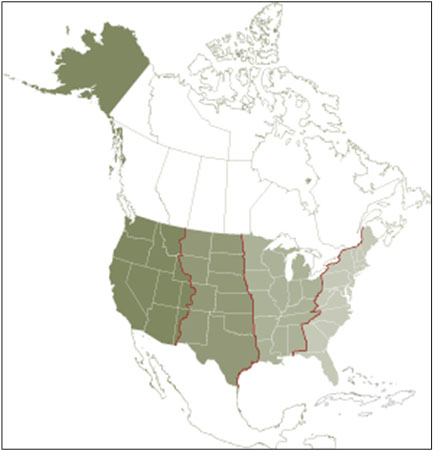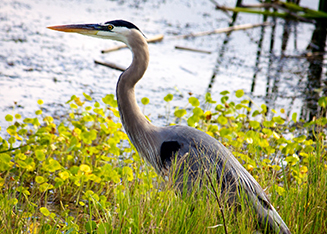Webless Migratory Game Bird Program
The Webless Migratory Game Bird (WMGB) Program is an outgrowth of the WMGB Research Program (1994-present) and the WMGB Management Program (2007-present). The revised WMGB Program was designed to provide cooperative funding for both research and management activities from the U.S. Fish & Wildlife Service, state wildlife agencies, and other sources for projects benefitting the 16 species of webless migratory game birds in North America (Table 1).
Click the links below for more details about the program.
The WMGB Program is an outgrowth of several funding initiatives, both past and present. The first effort was the Accelerated Research Program (1967-1982). Congressional funding of the ARP was $250,000 annually. Of this total, $175,000 was contracted to states: $50,000 was used directly by the U.S. Fish and Wildlife Service to support 2 field stations to study woodcock and doves; and $25,000 was retained by the USFWS to administer the program. The ARP ended when funding for the program was eliminated due to USFWS budget constraints in 1982.
In 1984, the International Association of Fish and Wildlife Agencies (now AFWA) formed the Migratory Shore and Upland Game Bird (MSUGB) Subcommittee. One goal of the subcommittee was to reinstate a webless game bird research program. To accomplish this goal, the subcommittee documented the past accomplishments of the ARP and lobbied for reinstatement of a webless research program. The efforts and persistence of the MSUGB Subcommittee came to fruition in the fall of 1994 when funding became available. The new program was titled the WMGB Research Program. Projects were selected for funding beginning in 1995 with funding obligated for the entire project. Detailed information about the history of the ARP and WMGB Research Programs can be found in Dolton (2009).
The WMGB Research Program was funded at various levels during 1995-2006; however, funding was suspended due to budget limitations in 2003 and 2004. Funding was reinstated in 2005 at a level of $250,000/year, with $30,000 of the total obligated for webless projects in USFWS Region 5 (Northeast U.S.).
In 2007, the USFWS received additional funding for MSUGB work ($487,000/year). The primary purpose of the new funding was to address the management needs of MSUGB. From 2007-2009, funding was directed towards supporting mourning dove banding in several states and other management related projects for woodcock, rails, and sandhill cranes. Another key contribution made by the MSUGB Subcommittee was the publication of the book "Migratory Shore and Upland Game Bird Management in North America" (Tacha and Braun 1994). This was a revised and updated version of the book edited by Sanderson (1977).
Priority research and management activities identified in these books served as a tool for evaluating proposals submitted to the WMGB Research Program for funding. AFWA's MSUGB Working Group (formerly MSUGB Subcommittee) provided key support in acquiring the additional funding. Due to the addition of funding for management-related projects (as opposed to research-only projects), cooperators made the decision to drop "research" from the title of the WMGB Program.
The MSUGB Working Group created the MSUGB Task Force in 2006 in order to update the priority research and management needs identified in Tacha and Braun (1994) and to develop funding strategies for the identified priorities. The task force decided that the best method to identify priorities and estimate costs for completing the priorities was to convene a series of workshops for the webless species identified in Table 1.
The workshops were designed to include broad representation from experts (e.g., federal and state agencies, conservation organizations, and university researchers) for each species-specific group. To date, the MSUGB Task Force has completed strategies identifying priority information needs for:
(1) mourning and white-winged doves,
(2) hunted rails and snipe,
(3) sandhill cranes,
(4) American woodcock,
(5) American coots, purple gallinules, and common moorhens, and
(6) band-tailed pigeons, Zenaida Doves, white-tipped doves and scaly-naped pigeons.
The completed priority information-need strategies are available on our Priority Information Needs page
These webless funding programs have proved to be invaluable in providing much-needed funding for webless species that receive considerably less attention than waterfowl. Through 2015, the Webless Program has supported a total of 139 research and management related projects totaling $6.6 million in WMGB Research and Management Program funds. Projects completed through the program have resulted in improved knowledge and management of webless migratory game birds. Previous annual abstract reports contain results of projects completed through the program.
The USFWS Project Officer for the WMGB Program distributes an annual request for proposals (RFP) in September to USFWS Flyway Representatives, Regional Migratory Bird Coordinators, USGS-Biological Research Division (BRD) Regional Offices, and the USGS Cooperative Research Units office. In addition, the funding opportunity is posted at: www.grants.gov. Flyway Representatives are responsible for distributing the RFP to biologists in their respective states. State biologists, in turn, are asked to send the information to other state personnel, universities, and any others who may be interested. Migratory Bird Coordinators forward the letter to National Wildlife Refuges and other federal offices. USGS-BRD Regional Offices are asked to forward the RFP to all their respective Science and Technology Centers, while the Cooperative Research Units office distributes the RFP to all Cooperative Fish and Wildlife Research Units. Funding proposals may be submitted for any webless migratory game bird identified in Table 1. Proposals may be oriented toward research or management-related projects. At least 1/3 of the total project cost must come from a funding source other than the WMGB Program. In- kind services, such as salaries of state employees and vehicle expenses, are acceptable as matching funds. Additionally, a letter of support is required for each proposal from the state in which it originates. Proposals for the program are due in November each year.
Four regional review committees (Fig. 1) that follow the boundaries of the North American Flyways (Fig. 2) rank all proposals submitted to the program. The Flyway-based committees are composed of individuals with knowledge of the research and management needs for these species. The chairperson of each Flyway-based review committee serves on a National Review Committee (NRC), which makes final project selections based on input from each Flyway-based committee. The NRC is composed of the Flyway- based Chairs, the U.S. Fish and Wildlife Service Program Manager, and Representatives from the Migratory Shore and Upland Game Bird Support Task Force. The NRC evaluates and ranks proposals based on how well the proposals address the priority information needs that have been identified for the 16 species of Migratory Shore and Upland Game Birds. After project selection, the NRC is responsible for developing an explanation documenting why successful projects were selected for funding. In addition, the NRC provides unsuccessful applicants with comments on why their project was not funded. 
Figure 1. Diagram of review process for proposals submitted to the Webless Migratory Game Bird Program.

Figure 2. Map of North American Flyway boundaries in the United States. Proposals working with the 16 species identified in Table 1 will be accepted from throughout North America.
Text from this webpage was taken directly from the following: Dolton, D.D., and T. R. Cooper. 2012. History and Administration of the Webless Migratory Game Bird Program, 1995-2012. In Webless Migratory Game Bird Program, Project Abstracts – 2010 and 2011. United States Department of the Interior, Fish and Wildlife Service, Bloomingtion, MN USA. 140p.
Dolton, D.D. (compiler). 2009. History and administration of the Webless Migratory Game Bird Research Program, 1995-2008. In Webless Migratory Game Bird Research Program, Project Abstracts – 2008. United States Department of the Interior, Fish and Wildlife Service, Denver, Colorado. 66 pp. http://www.fws.gov/birds/surveys-and-data/webless-game-birds/webless-migratory-game-bird-program/project-abstracts.php
Sanderson, G.C., editor. 1977. Management of migratory shore and upland game birds in North America. International Association of Fish and Wildlife Agencies, Washington, D.C. 358 pp.
Tacha, T.C., and C.E. Braun, editors. 1994. Migratory shore and upland game bird management in North America. International Association of Fish and Wildlife Agencies. Washington, D.C. 223 pp
| Table 1. The 16 species of migratory shore and upland game birds eligible for funding through the Webless Migratory Game Bird Program. | |
| Common Name | Scientific Name |
| King Rail | Rallus elegans |
| Clapper Rail | Rallus longirostris |
| Virginia Rail | Rallus limicola |
| Sora | Porzana carolina |
| Purple Gallinule | Porphyrio martinica |
| Common Gallinule1 | Gallinula chloropus |
| American Coot | Fulica americana |
| Sandhill Crane | Grus canadensis |
| Wilson’s Snipe | Gallinago delicata |
| American Woodcock | Scolopax minor |
| Band-tailed Pigeon | Patagioenas fasciata |
| Scaly-naped Pigeon | Patagioenas squamosa |
| Zenaida Dove | Zenaida aurita |
| Mourning Dove | Zenaida macroura |
| White-winged Dove | Zenaida asiatica |
| White-tipped Dove | Leptotila verreauxi |
1-Formerly Common Moorhen


